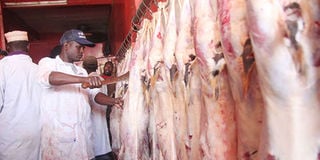Kiamaiko abattoir operating illegally as license not renewed

Kiamaiko goat slaughterhouse in Huruma, Nairobi. The slaughterhouse is on the spot for continuing to operate without a valid licence. PHOTO | FILE | NATION MEDIA GROUP
What you need to know:
- The popular goat slaughterhouse has been operating without a license for three weeks now.
- People slaughtering animals at the slaughterhouse have hired residential houses for their operations.
- City Hall director of veterinary services said that the slaughterhouse's sanitation standard cannot be improved.
- Last year, Nema closed down all slaughterhouses in Kiamaiko for failing to comply with various regulations.
Kiamaiko slaughterhouse in Nairobi is on the spot for continuing to operate without a valid licence, putting into doubt the safety of meat from the abattoir.
This comes after Nairobi County government revealed it has not renewed the abattoir's license because it has not met certain health standards.
City Hall Agriculture executive Pauline Kahiga said the popular goat slaughterhouse has been operating without a license for three weeks now after the county decided against renewing its license for failing to meet sanitation standards.
"The slaughterhouse has already identified a place in Ruai where it will be relocating to but in the meantime there are some renovations going on. However, as a remedial action, we did not renew their licenses," said Ms Kahiga Monday during a visit to the slaughterhouses.
ILLEGAL OPERATION
The county's Chief Officer for Water Mohamed Abdi stated that the abattoirs have not complied with the requisite sanitation standards as per the law, adding that Nairobi City Water and Sewerage Company has not issued any licenses to the slaughterhouses.
On his part, City Hall Director of Veterinary Services Muhari Muriithi said that the slaughterhouse's sanitation standard cannot be improved with the only option being its relocation.
He said that the slaughterhouse, which is located at the centre of large human settlement with the huge population overcrowding the facility, lacks efficient effluent system as well as proper entry and exit points making it difficult to implement food safety standards.
"Despite what we can do, Kiamaiko cannot be improved beyond what it is now and the solution has to be relocation," said Dr Muriithi.
However, Imara Daima MCA Kennedy Obuya, a member of county Agriculture committee, said the committee had recommended that Kiamaiko be retained as a market and the slaughterhouse relocated to another place but that has not been actualised.
UNHYGIENIC
Water Committee Chairman Paul Kados further questioned why the slaughterhouse is still operating if it has not complied with the required standards.
This was after City Hall Deputy Director for Public Health Kenneth Mando revealed that the effluent being released from the abattoirs is not treated as required by law.
Trade Committee Chairman Charles Thuo said people slaughtering animals at the slaughterhouse have hired residential houses where they slaughter while the market is only used as a holding ground.
This is not the first time the slaughterhouse is coming under criticism for its poor sanitation standards.
Last year April, National Environmental Management Agency (Nema) closed down all slaughterhouses in Kiamaiko for failing to comply with various regulations, especially the management of solid and liquid waste.
UNFIT LOCATION
According to Nema, the slaughterhouses lacked waste water pre-treatment and quality analysis facilities with the slaughterhouses being a major source of pollutants in Nairobi River.
In December the same year, Nairobi County Environment Committee, in its report, faulted the abattoir's hygiene conditions saying that its location in a densely populated area made the slaughterhouse unfit as a food handling facility.
The report also faulted the drainage system and the general environment around the abattoir located in Eastlands, especially the drainage system outside the facility which they termed "not all that good", calling for its relocation.





